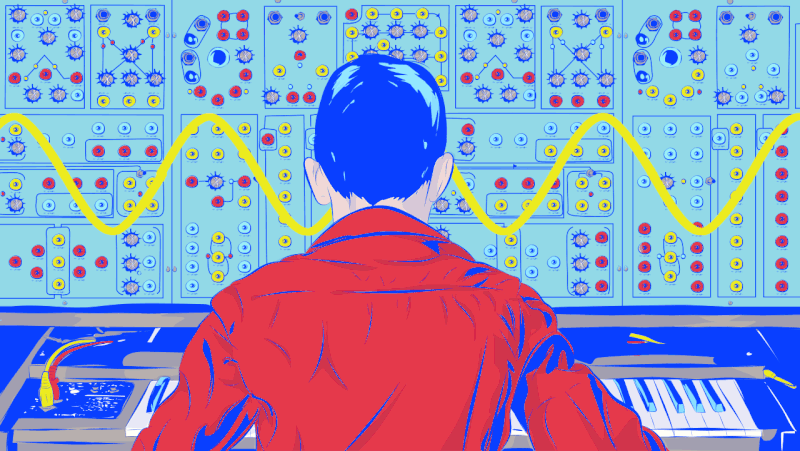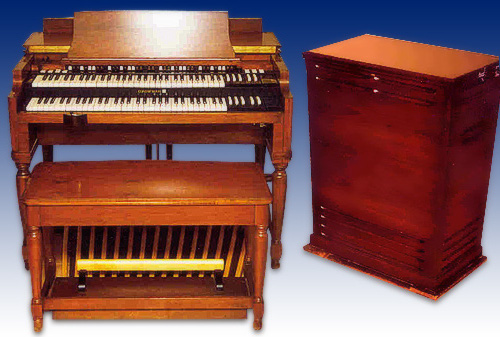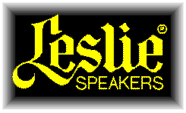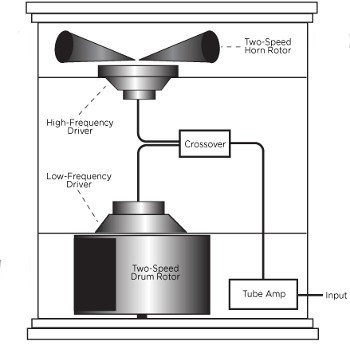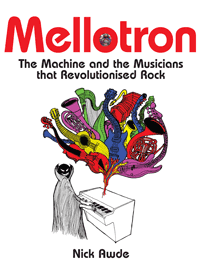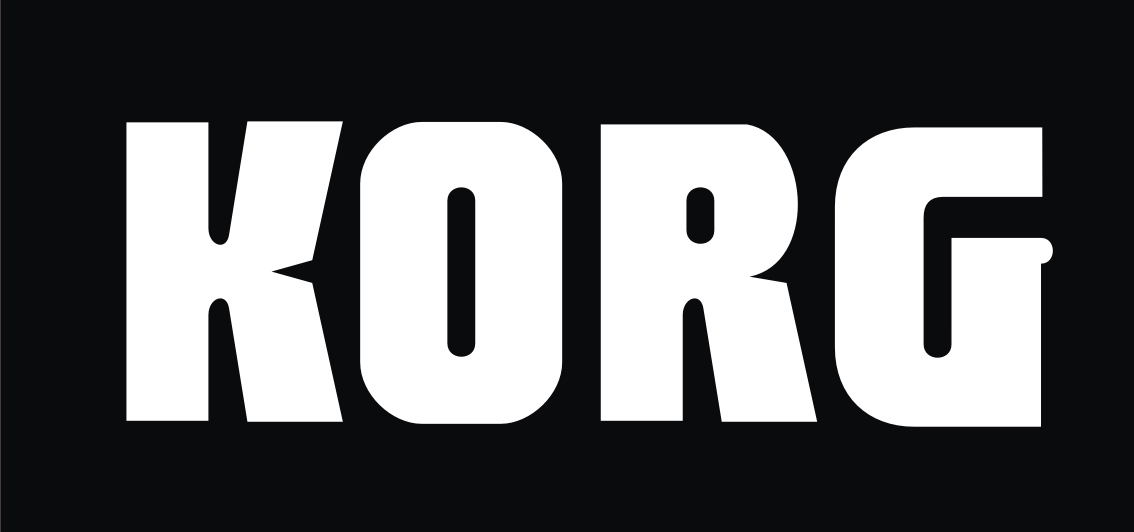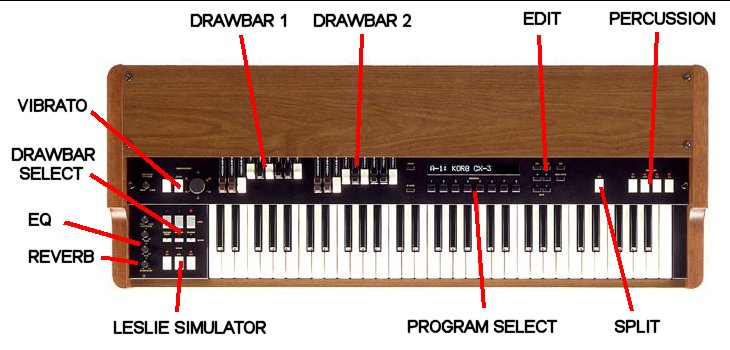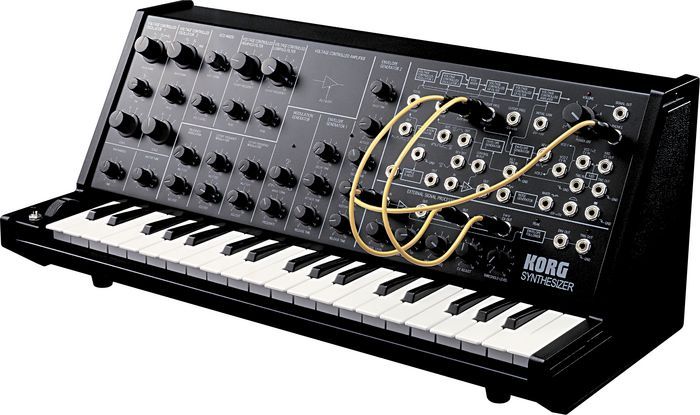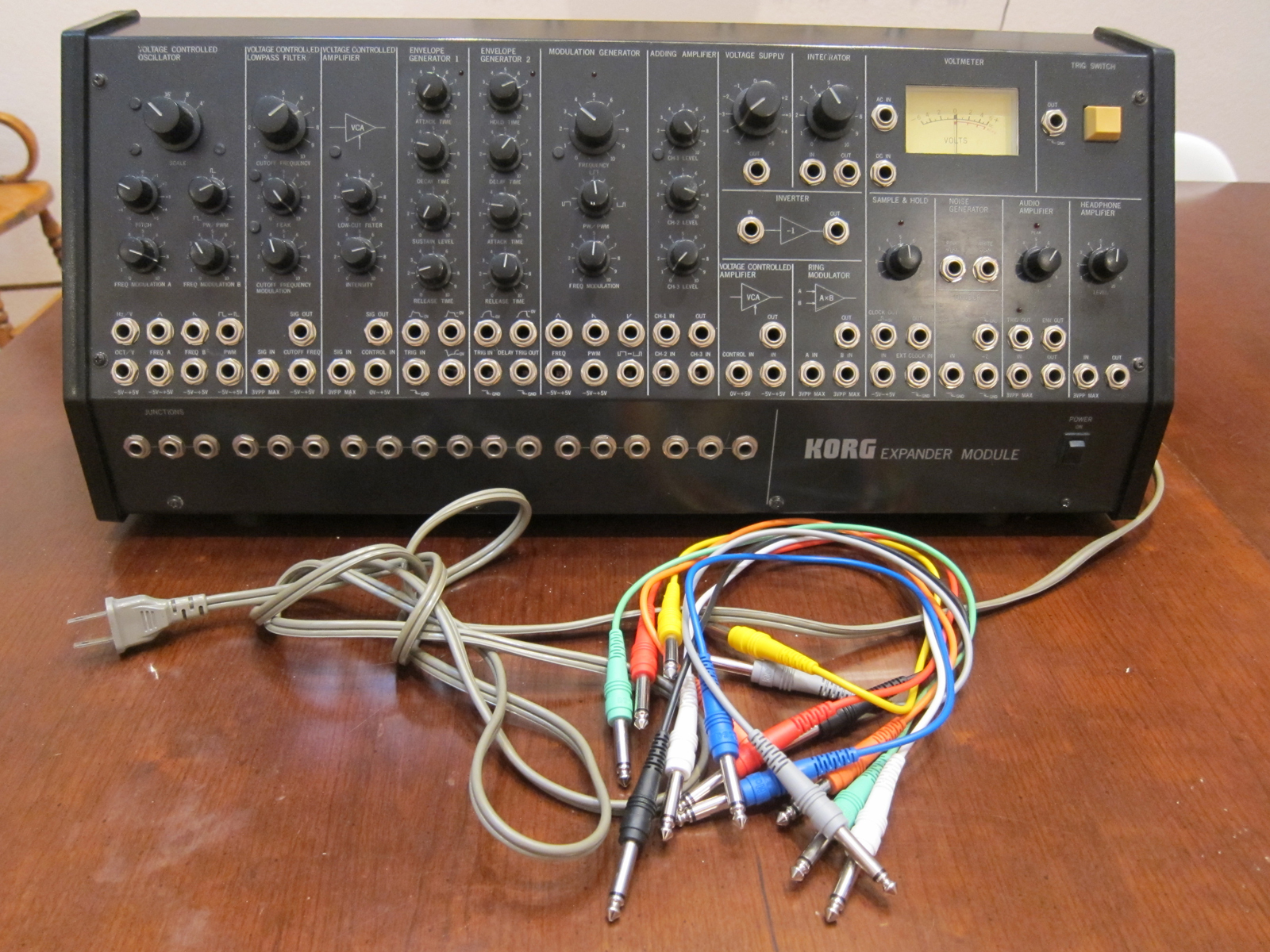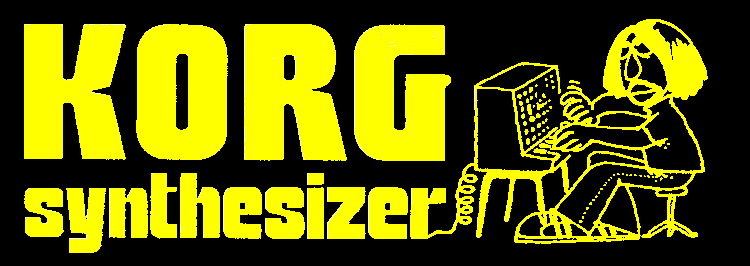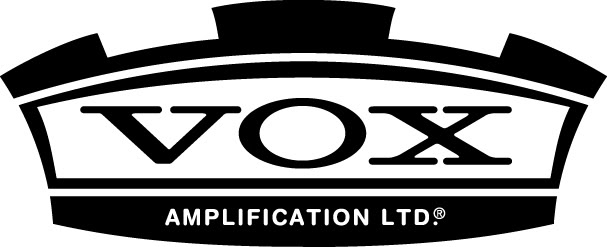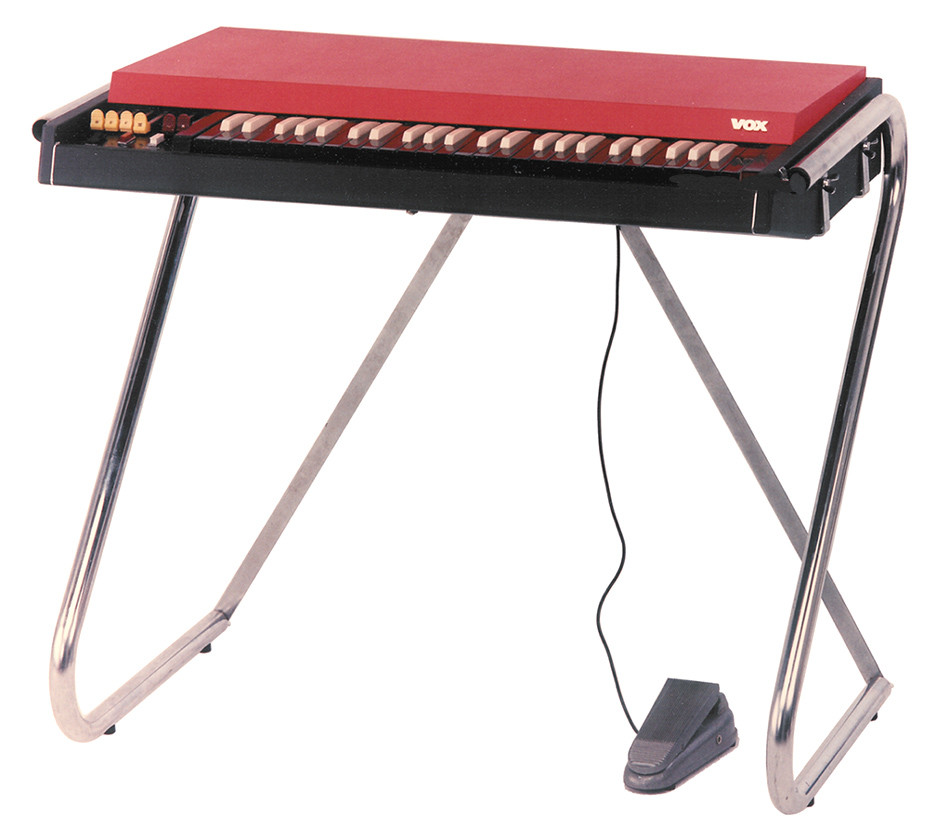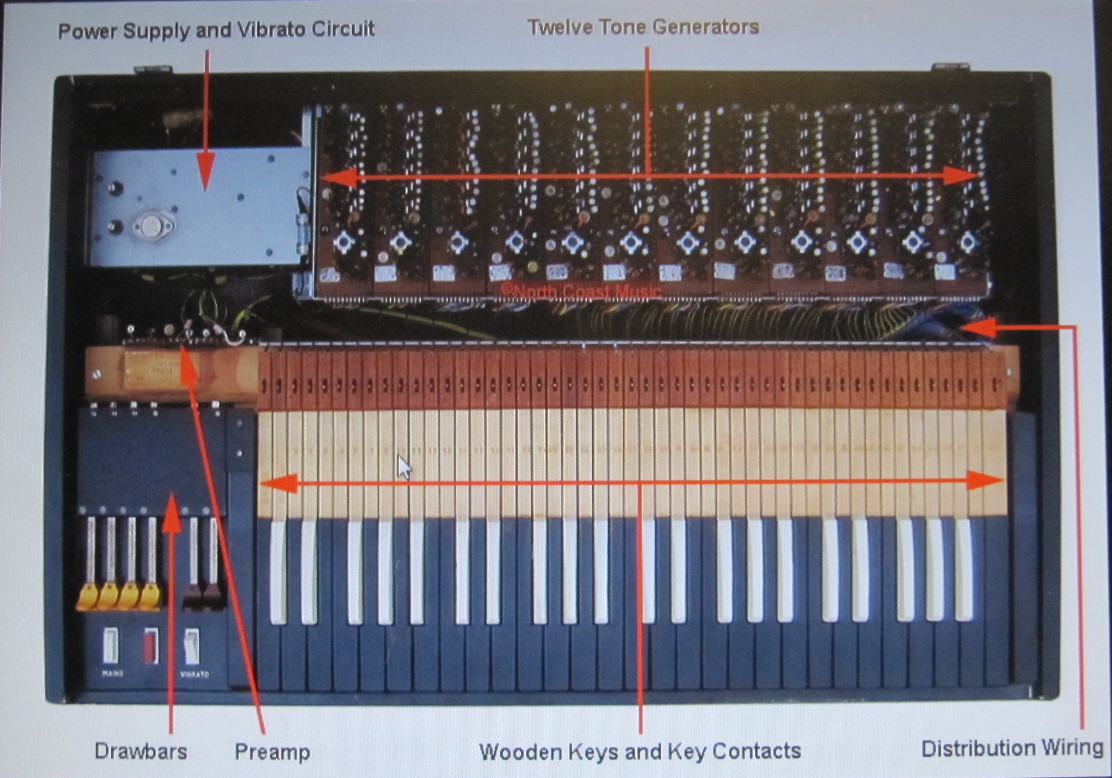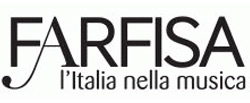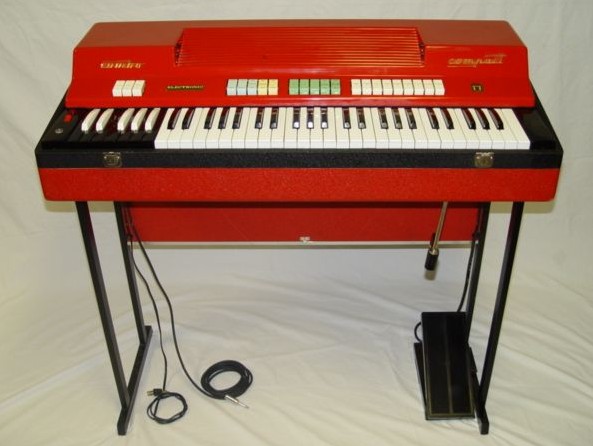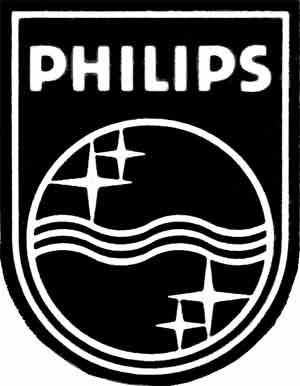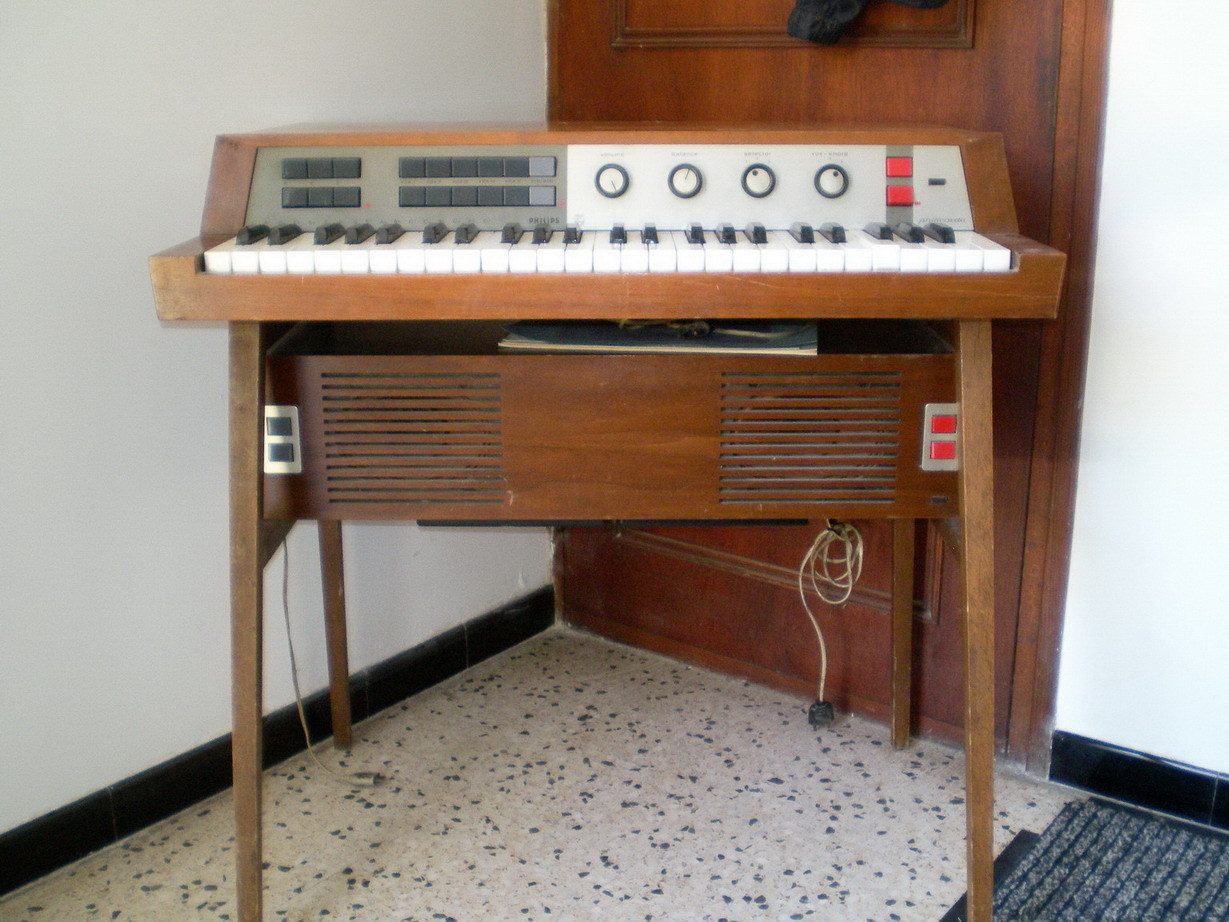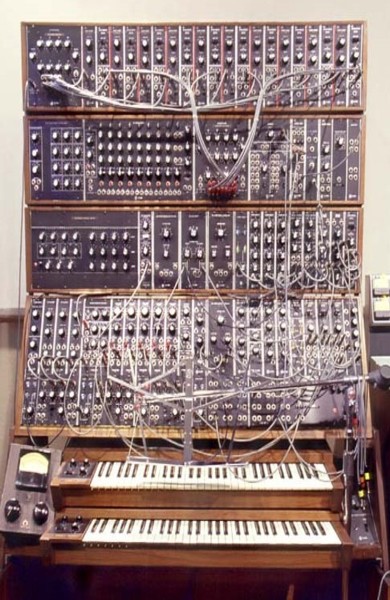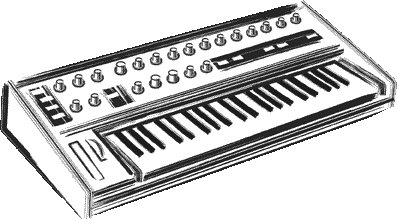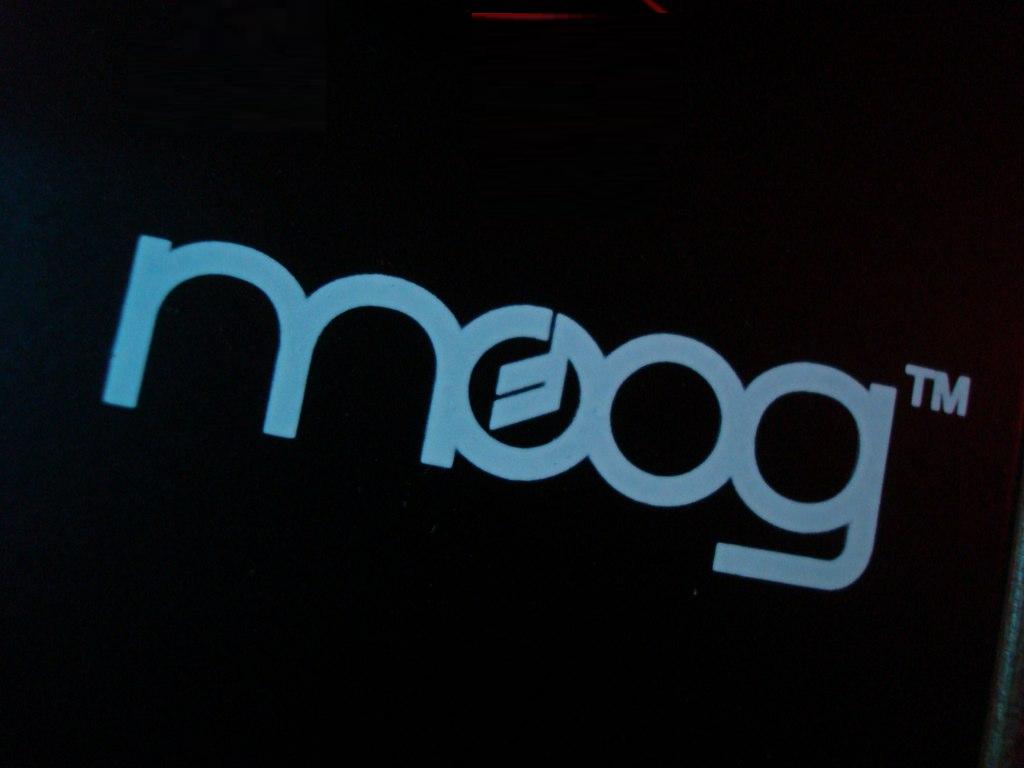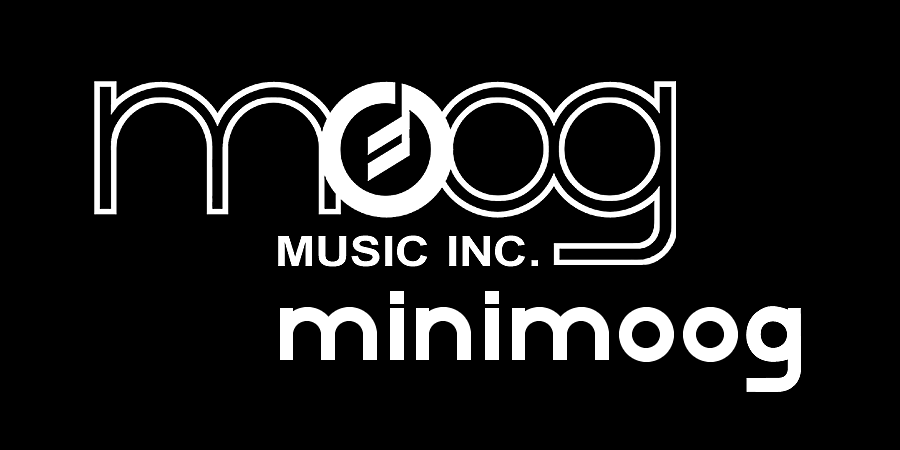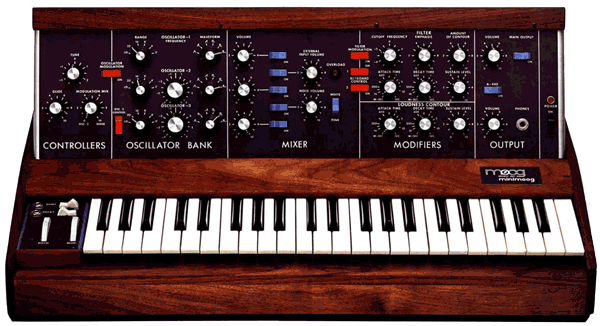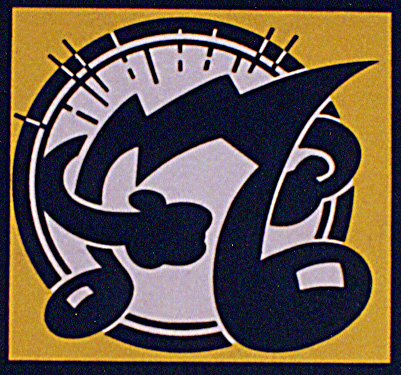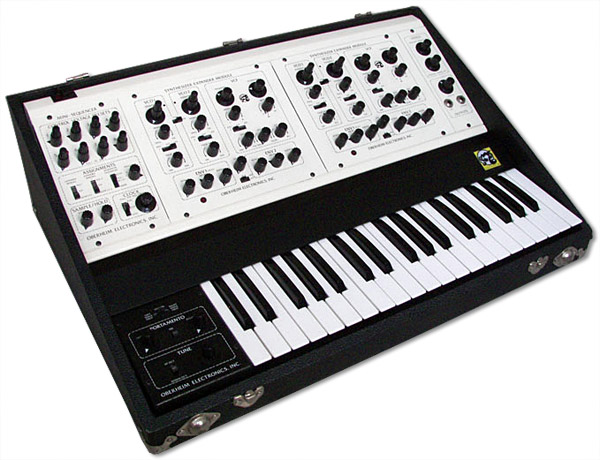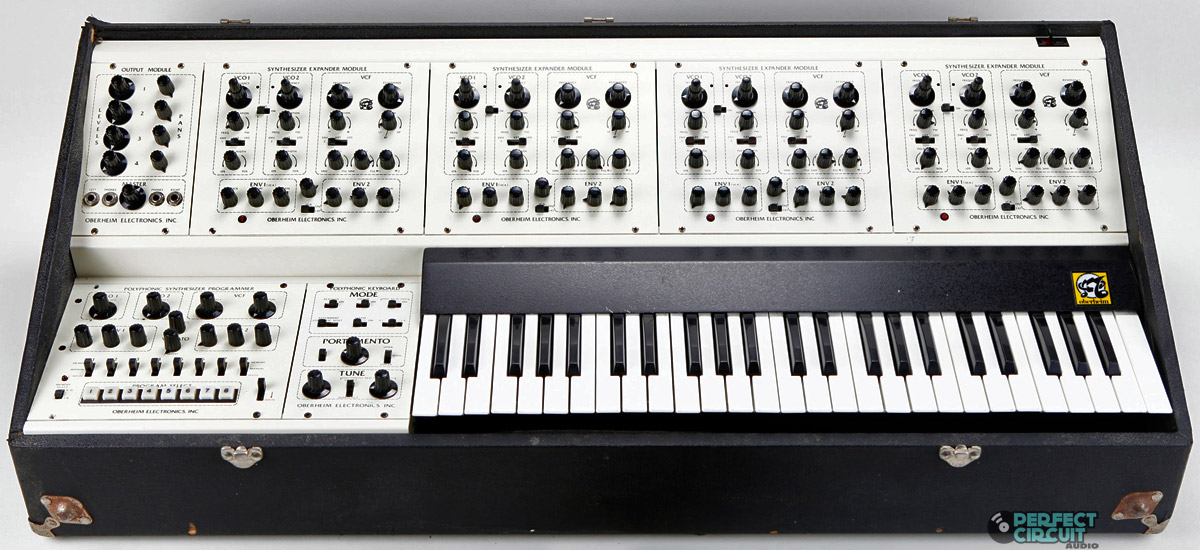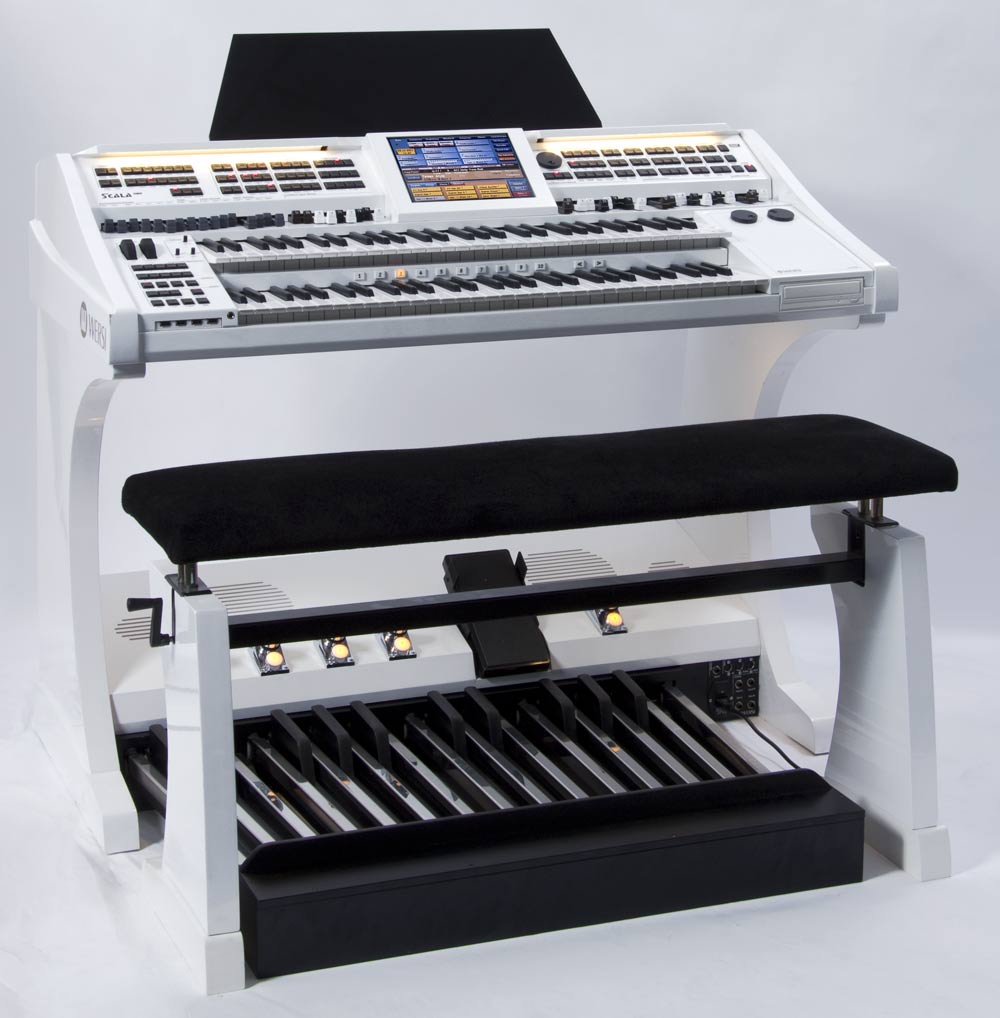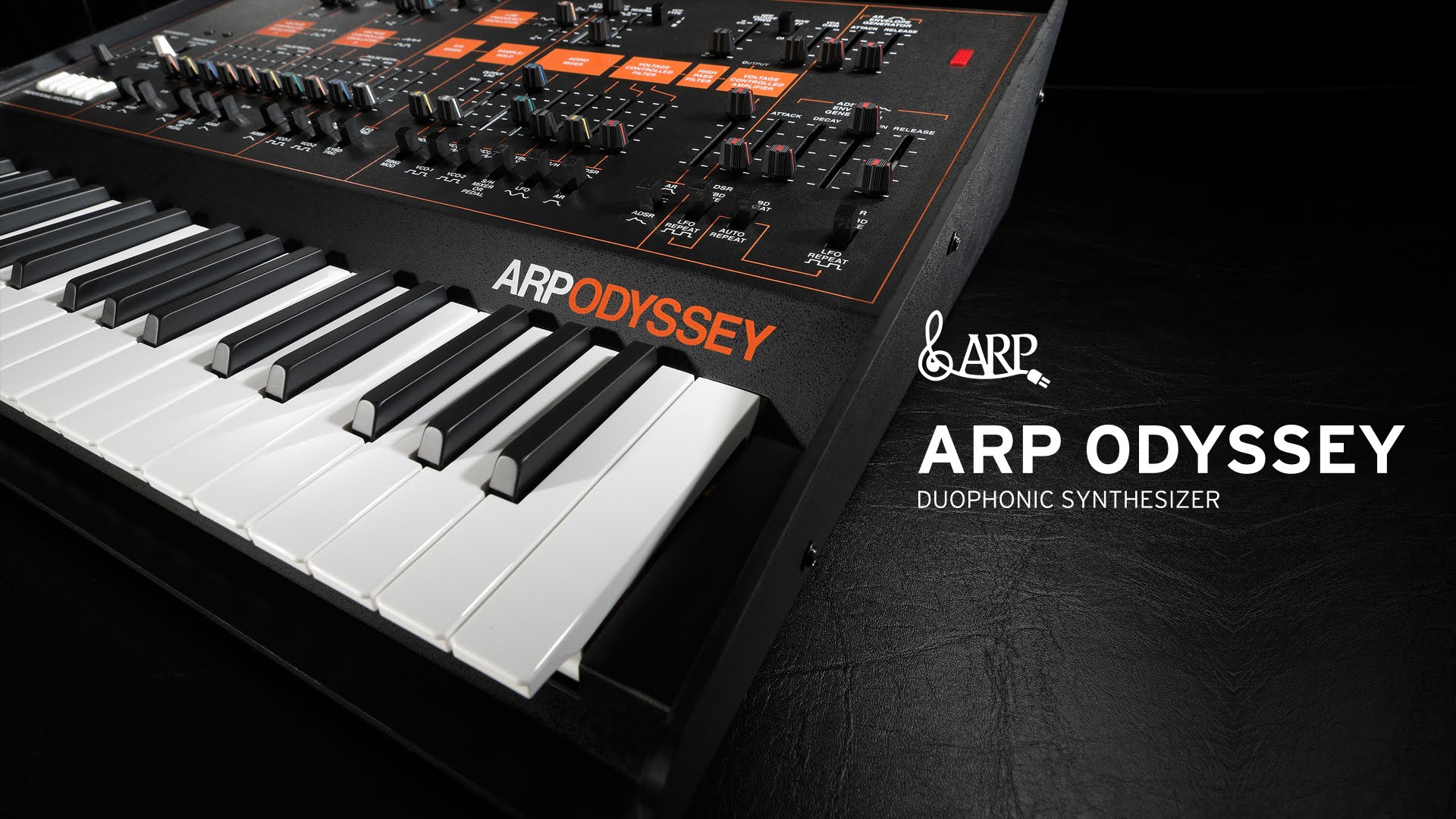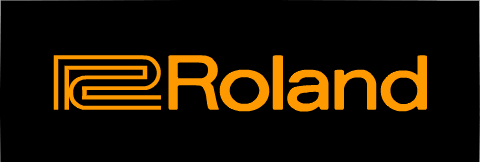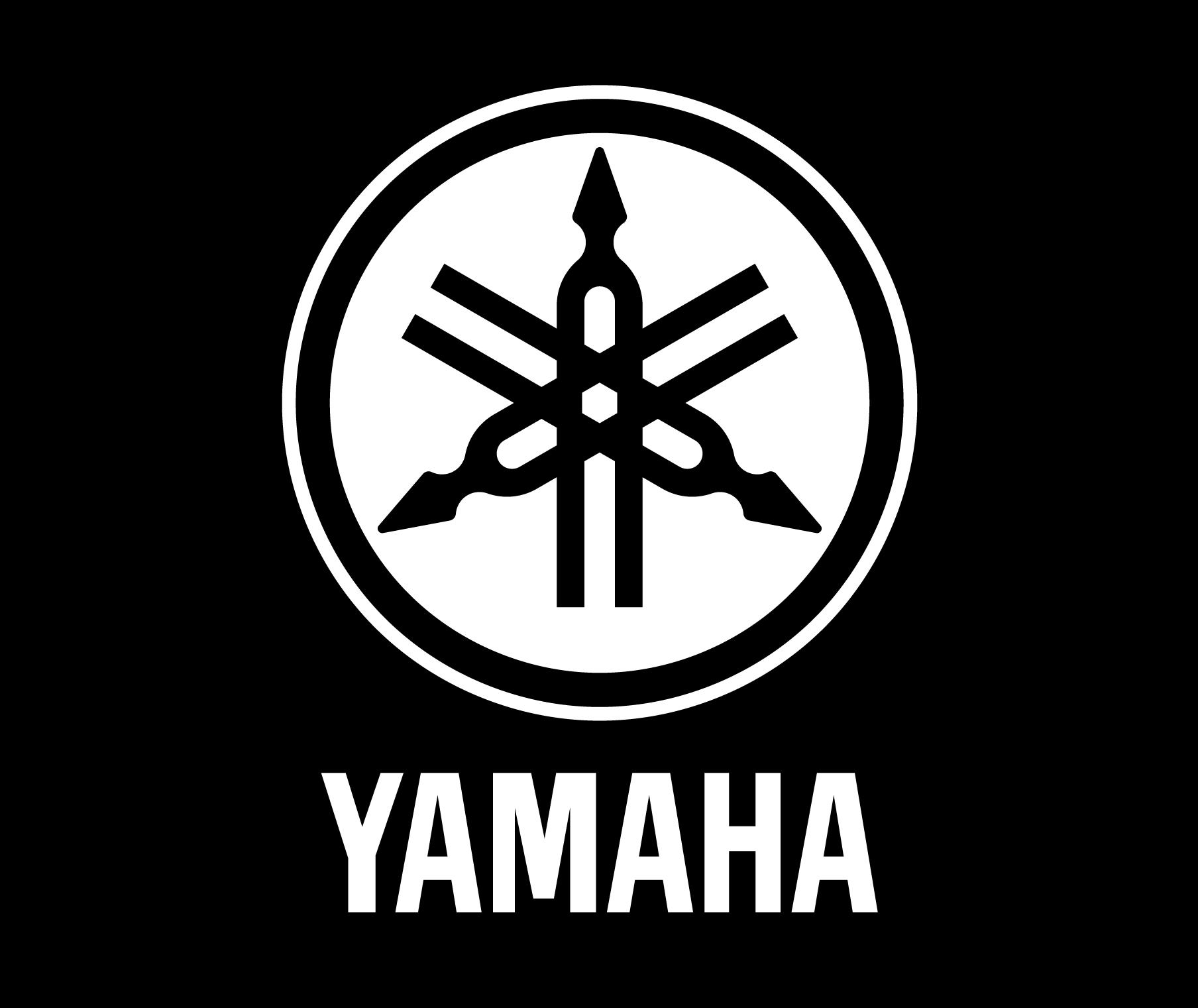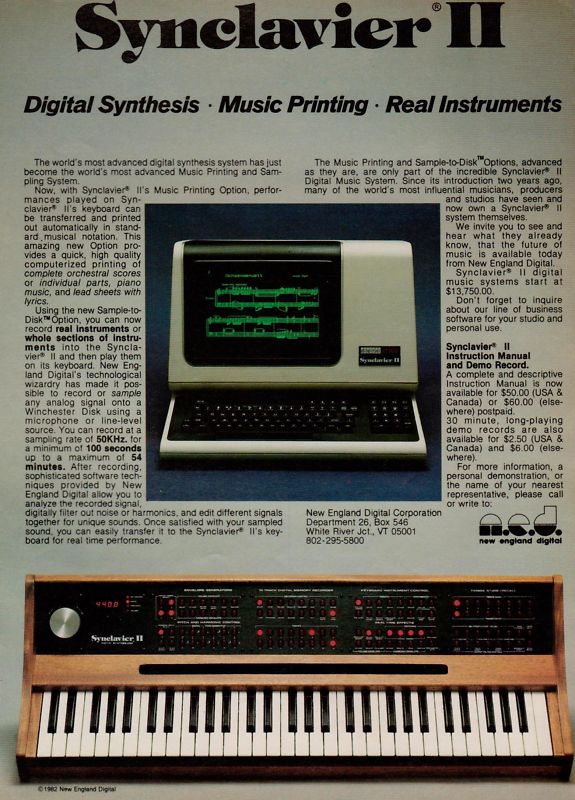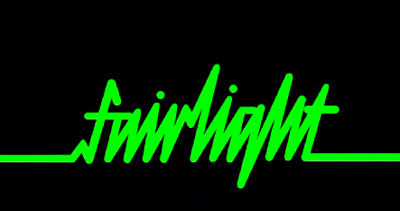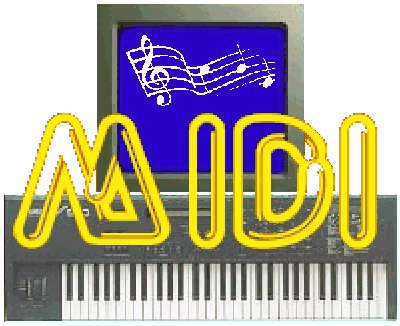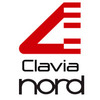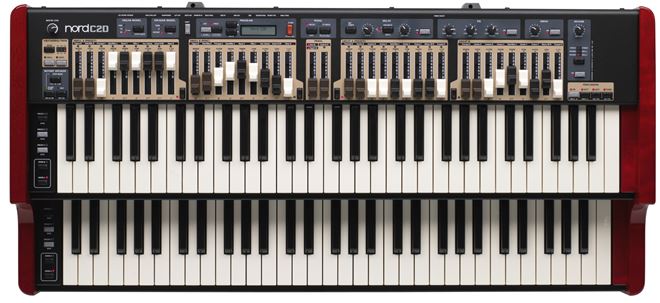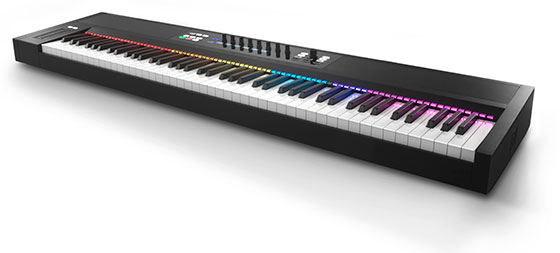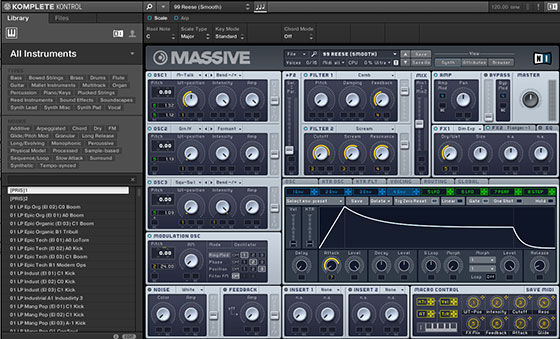Organ & Synth
In the series about rock music hardware, we take a look at electric organs & synthesizers.
Technical and musical greetings from
Kurt Starlit
- aka CykelKurt
This series includes:
Latest update: 2016.April.12
===================================================
The Hammond organ (1935)
The Hammond organ and the Leslie speaker today are closely interwoven with rock and jazz music, that it seems unlikely they were originally designed for church music. Countless private church communities in the US never had the economics to purchase expensive pipe organs.
To get into this market, Laurens Hammond (1895-1973) in the 1930s designed and produced a much cheaper electric competitor to the mechanical pipe organ.
Each single tone of a Hammond organ is generated by a (mechanical) tone wheel which, during its rotation, is transferring electromagnetic energy ("sound") into a pick-up. In principle, an organ pick-up is much like a guitar pick-up.
The pickup converts the electromagnetic energy into an electrical signal, which can be processed, amplified, and finally sent into a loudspeaker.
Hammond B3 med Leslie 122
Hammond claimed, that his organ could generate sound(s) as well as any pipe organ (where sound is generated by air flowing trough a pipe).
A sound generator in a Hammond organ is generating the basic tone which, by means of a number of drawbars, are adding harmonics in accordance with the setting of these drawbars.
In this way, the Hammond organ in principle is able of creating any sound the pipe organ can do.
As already explained, Mr. Hammond developed his organ for small churches. However, it did not take long before jazz and rock musicians got their eyes (or should we say ears) opened too. For example, take a listen to this recording with Jimmy Smith playing "Organ Grinders Swing"). Or this recording with Procol Harum playing ( "A Whiter Shade of Pale").
Hammond organ (Wikipedia)
Taking size and weight of a Hammond organ into consideration, there are a number of mechanical issues to deal with. So, unless you stick to these mechanical giants no matter what, it could be worthwhile to take a look at Swedish CLAVIA Nord, model C2.
Clavia Nord C2 (YouTube)
The Leslie speaker (1941)
The Leslie speaker
is a combined amplifier and two-way loudspeaker system. It is most commonly associated with the Hammond organ, though it can be used for the guitar and other instruments as well.
The Leslie is characterized by its "rotating" sound with a woofer placed over a rotating funnel, from where the sound is spreading in the room. The tweeter is mounted on a rotor with a horn through which the sound is dispersed.
The musician controls the Leslie by either an external switch or foot pedal that alternates between a slow and fast speed setting, known as "chorale" and "tremolo". On some models, the two rotations are controlled separately.
The resulting sound seems to be coming ever changing places in the room. The effect resembles a phaser, flanger or chorus pedal.
Most people, who have heard a Hammond B3 organ with two Leslie cabinets (located 3-8 meters from each other), will agree that it is a very special experience.
Leslie demo:
A note is played on the Hammond organ,
while changing between "Chorale" and "Tremolo" setting and back again on the Leslie cabinet.
Fender Vibratone and others
Blockdiagram of a Leslie cabinet
Hammond C3 with Leslie 122 (note the bass playing)
Four Hammond B3s playing "The Cat"
===================================================
CASIO (1946)
The Japanese company Casio from the very beginning spread over a large product area. They have manufactured a multitude of electronic products like electronic clocks, pocket calculators, mobile phones and musical instruments.
Music instruments were only a minor part of a huge program, which where aiming at the average customer - not the musician.
Casio always had this image of making toys, meaning that you didn't have to take their gear too seriously. Did you need, for example, a cheap synth in a hurry, you only had to go for the nearest toy retailer and as for Casio.
Wheather the toy-like image is still hanging on, is a question hanging in the air. A year ago (2012) I tried to look at on a few pages of a Casio synth catalog, but got terribly bored after 27 seconds...
Instead, let us take a random selection from the long history of Casio products:
1946 - the Casio company is founded in Tokyo, Japan
1957 - Casio 14A, the first electronic pocket-calculator in the world, is launched
1974 - the electronic watch Casiotron is launched
1980 - the electronic keyboard Casiotone 201 is launched
1981 - the electronic dictionary, TR-2000, is launched
1982 - the analog wristwatch AQ-500 is launced
1984 - digital synth, model CZ-101
1986 - Sampletone synth, model SK-1, with sample function
Casio synth (YouTube)
===================================================
Chamberlin (1956)
The Chamberlin keyboard is considered to be a precursor to the Mellotron.
The first model was launched in the United States, 1956.
The idea is, that you by means of a keyboard are controlling a number of tape loops containing various sounds.
The belt loops can be replaced with, for example, recordings of various instruments or other sounds.
One of the original recordings is called "3 Violins". This sound is making rock groups interested in the Mellotron (some time around 1960), because in this way, they can use the sound of strings on stage.
One of Chamberlin's employees (Franson, a salesman) takes the Chamberlin (instrument) to England, where he renames the beast into Mellotron, starts his own business (Streetly Electronics) and sells Mellotron to anyone who will buy.
The Mellotron becomes famous, as it is used by groups like Moody Blues, who become close to synonymous with the Mellotron with the release of a number of records, e.g. "Nights in White Satin"
Nick Awde's book on the Mellotron
At home in the US Chamberlin has heard rumors of this English version of his instrument. A lot of trouble arises with lawsuits and everything, but finally an agreement is made, that the Mellotron is only to be sold in England, and the Chamberlin exclusively in the US. Furthermore, Chamberlin recieves commission of the Mellotrons sold in England.
With this agreement, Franson is authorized to use the tape loop named "3 Violins". This sound almost becomes the trademark of Mellotron in the years to come.
So, how does it work, the Mellotron?
Well, if you take a look at various mechanical drawings and explanation of the motions, the tape necessarily have to make (to generate sound), it seems unavoidably that a lot of trouble lies ahead.
The old echo machines (with small tape loops) were bad enough, but compared to the Mellotron, they seem like a piece of cake.
From an electronic point of view, the Mellotron doesn't much worse (or better) than most other electronic products, so, with this in mind, how does the machine work in practice?
Mechanically, the Mellotron is extremely sensitive to temperature changes and moisture. It should be treated like I don't know what before, under and after... especially transportation is an issue.
Many stories are circulating about The Moody Blues and their Mellotrons. Several times they had to give up using the Mellotron bacause it had been subjected to a mechanical schock during transportation.
Luckily this is all a part of the past. Today, the Mellotron has been developed into a digital version, model M400D, which is far better. It was launched in 2010.
===================================================
KORG (1962)
The KORG company is founded 1962 in Japan by mr. Tsutomu Katoh and mr. Tadashi Osanai.
In 1963, Doncamatic DA-20 is introduced - an electronic rhythm box with a rotating disc system.
The same year, mr. Mieda is employed by the KORG company. He is an engineer, who builds a new type of monophonic programmable organ. In practice, though, he has built a synthesizer. 50 examples are manufactured and sold under the KORG trademark, which is a contraction of the letters Keio and ORGan.
PE-1000, PolySix og verdens første workstation, Korg M1.
Down through the years, KORG has developed a great amount of epochal-making products such as PE-1000, PolySix and the world's first work station, Korg M1.
KORG (US)
KORG (Wikipedia)
List of KORG products
KORG CX-3
Around 1980, the KORG CX-3 organ is launched. It is inter alia equipped with the infamous Leslie rotary effect as of that time is a sensation and put the organ in a class by itself. With this handy device you get the coveted drawbars and the incomparable Leslie effect without having to lug around a monstrous Hammond organ and Leslie cabinet.
Among other qualifications, the CX-3 is equipped with the famous Leslie rotary effect, which at this time is a sensation and puts the organ in a class of its own.
With this handy device you get the much coveted drawbars and the imcomparable Leslie effect without having to carry a monstrous Hammond organ and Leslie cabinet on your sore backbone.
The modular synth
KORG MS-20
In the years 1978-83, KORG is producing a monaural (single note) analog synth, which in its structure is modular. This means that each module (VCO, VCA, EG etc.) can be connected (used) individually or in association with each other in any order. This is done by connecting each module with jack cable(s) - in this way controlling the signal routing and/or controlling the sound.
If there's no jack cable connected, the synth works like any other synth, meaning the modules are connected the stadardized way: VCO ----> VCF ----> VCA .
Korg monophonic synth, model MS-20, lauched in 1978.
MS-20 is part of a series which includes:
MS-10 (looks very much like MS-20, but with just one VCO),
MS-50 (a box with a lot of mudules (VCO, VCF, VCA, EG, ADSR o.s.v.), but without any keyboard),
SQ-10 (Sequencer),
VC-10 (Vocoder),
MS-01 (foot pedal controller),
MS-02 (Interface),
MS-03 (Signal Processor) og
MS-04 (Modulation Pedal).
In 2013, MS-20 is re-launched, as a response to a growing interest among young people for analog synthesizers.
The new MS-20 is launched at a reduced physical size (15% smaller than the original) and equipped with mini-jack instead of standard jack. Furthermore with the addition of USB and MIDI - but otherwise identical to the original model.
In 2014, Korg launches a MS-20 kit in 100% scale under the name "MS-20 Kit" - with USB and MIDI.
Korg MS-20 (monofonisk synth m. tastatur)
Korg MS-20 (YouTube)
KORG MS-50
large pic.
KORG MS-50 is the top model in the MS series by Korg. It comes without any keyboard and for this reason shall be controlled from an external keyboard or other voltage source.
MS-50 is 100% modular, i.e. all modules are independent from one another, each having (at least) a separate (controlling) input and an output.
The modules may be connected in any order and way, which provides huge potential.
Furthermore, the MS-50 can work with MS-20 and SQ-10 or any other device or module in the MS series.
Among many modules, a Ring-Modulator, Volt-Meter and a S/H (Sample & Hold) module should be mentioned.
Personally, I purchased an analog KORG system around 1980 (MS-04, MS-20 and MS-50), but even today there is great interest in the old models, as their applications are almost unlimited.
Korg MS-04 (Modulation Pedal)
Korg MS-04 (YouTube)
Korg MS-50 (monophonic synth without any keyboard)
Korg MS-50 (YouTube)
===================================================
Vox Continental (1962)
English Vox organ, model Continental
large pic.
Vox Continental organ was launched in 1962. Soon it was known as "Connie" with its typical pop-organ sound. The sound was not rich and fatty like a Hammond, but instead had a rather thin, but also distinctive sound.
Connie was made for the travelling musician and rock groups, but nevertheless it grew popular in the studio(s) as well. For example it is used on recordings by The Animals (1964), "House of the Rising Sun" and The Doors (1967) with "Light My Fire".
The Continental probably was the most popular organ in the 1960s, where it was used by the most famous groups, such as The Dave Clark Five and The Monkees.
For whatever reason, it went out of production in the early 1970s. Maybe it was due to competition from other producers, maybe it was due to a lack of interest among musicians who was gradually leaning more towards Hammond with its many sound options.
Continental was marketed in two different versions (plus variants): Single keyboard and dual keyboard. Furthermore, the organ was manufactured at several locations around the world (England, USA and Italy), each with their advantages and disadvantages.
In spite of a rather short production period (about ten years) the Vox Continental achieved great success and great sales. Even today, "Connie" is preferred by a number of groups and musicians worldwide.
A look into the beast
Vox Continental was built from transistors, which in many ways was a big step forward, compared to valve technology.
A transistor is working at a much lower voltage than a valve - usually less than 10 volts. A transistor doesn't take up the space of a valve, and is generating much less heat, and is generally working for much longer periods of time compared to a valve (valves are usually part of a tone-wheel organ like the Hammond) before servicing or repair is needed.
The price of a transistor organ is/was also only a fraction of what you, for example, would have to pay for a Hammond organ.
Most combo organs of the 1960s were more or less constructed the same way: 12 sound oscillators that produce 12 different tones (of a 12-tone scale, like a piano). A number of FREQUENCY DIVIDERS ensure that the notes are divided one or more octaves down, so that you end upwith an organ covering 4 octaves (49 keys).
When a key on a keyboard is pressed down, a signal (tone) is sent through a so-called BUS (in the picture called "Distribution Wiring "). A BUS is an electronic transportation and distribution system which leads various tone groups (e.g. 16 feet, 8 feet, 4 feet and 2 feet) to their respective FILTERS - one filter for each foot (octave). Harmonics are filtered out, so you end up with a number of characteristic sounds (flute, string, reed etc.) on the output of the filters.
After being re-mixed, all voices are sent on to a PRE-AMP, which amplifies the complete signal (the sounds) up and possible adds VOLUME, TONE, VIBRATO and REVERB, before the signal (the sounds) are finally ready to be sent out in real life - for example a combo amplifier.
Vox Continental (Wikipedia)
Vox Continental (YouTube)
===================================================
Farfisa Compact (1964)
Farfisa Compact in a typical red garb
The organ Compact series from Farfisa includes the models
Mini Compact,
Compact Deluxe and
The production of the Compact series was carried out in Italy, 1964 - 1970. Farfisa Compact, as an example, was launched in 1964.
The sound of a Farfisa organ was always something special. This is due to the fact, that sounds in a Farfisa organ is generated in a different way, compared to most other combo organs (e.g. VOX Continental).
VOX and many others are starting with a square wave (50% pulse-pause ratio), which is filtered down, according to the desired voice and timbre.
Farfisa, to the contrary, starts with a saw-tooth shaped pulse or wave, filtered down into a sinus tone (= without any harmonics). When a Farfisa organ player is regulating the swell pedal (with his right knee), a variable number of harmonics are added to the basic tone through a filter - in accordance with the position of the swell pedal.
In this way, the organ sound or timbre is changing.
This way of sound-generating allows the Compact organs considerably more tonal options than most other combo organs. For example, you may have heard the notorious "Farfisa-sound", which can be made more screaming, wild, and rough, compared to most other combo organs.
Farfisa
Farfisa Combo (YouTube)
===================================================
Philips Philicorda (1965)
Philips Philicorda
If you as a young musician didn't have too much money, but big ambitions, you could start a musical career by purchasing the low-priced Dutch Philcorda organ. It had a reasonable sound, and appeared resonable on stage. I saw a number of groups with this organ.
A strange choice was the inputs and outputs of the organ. They were all using the German DIN standard, with the rest of the industry using Phono or 6mm Jack connectors.
DIN connections were all right for home systems, where they were connected just one or maybe two times. But for professional portable music equipment, where all connections were pushed and pulled countless times, the DIN system was hopeless.
For the average home musician, Philcorda was delivered with an EP record ( "Philicorda Rhythm Record") plus a DIN input socket for turntable (or tape recorder), so that the home musician in this way could play the organ synchronously with the drums on the record:
The recording on this 33⅓ r.p.m. gramophone record are intended as a rhythm accompaniment to music played on the Philicorda. They have been made with the most frequently used forms of modern popular music in view. The refrain of the majority of these compositions consists of 32 bars or a multiple of 8, 12 or 16 bars. Hence a number of bars of rhythm have been recorded, such that the whole duration of each rhythm variation can be exploited to the full. In order to be able to start playing simultaneously with the rhythm of the record, a few beats, consisting of taps on the wood block, are given as a cue.
The Philips organ reminds a bit of VOX Jaguar. Moreover, it sometimes sounds like a Farfisa Compact, but certainly, it has got its own sound as well.
Philips Philicorda
Philips Philicorda (YouTube)
nnnnnnnnnnnnnnnnnnnnnnnnnnnnnnnnn nnnnnnnnnnnnnnnnnnnnnnnnnnnnnnnnn
The synthesizer - threat or opportunity?
Synthesizer (Moog, System 55 with extensions)
What is a synthesizer?
Oh boy, a question like that could be hard to answer.
One explanation could be,
a synthesizer is an electronic device for generating and processing sound.
Suitable to imitate instruments and other sounds, one might add, and
usually controlled from a keyboard, one might conclude.
The synthesizer has throughout its development spread to so many areas, that it nowadays often is serving as a complete studio with multitrack recording, mixer, sound modules, control of light, humidity and even bedtimes.
With the invention of the synthesizer, musicians and studios got the opportunity to work with creation of sound in general and processing of music in particular.
Processes that previously were terribly time consuming and involving lots of musicians and technicians, now suddenly was realized by a single person (greatly simplified) pulling a few wires and pressing a few knobs and/or buttons.
A lot of trial & error has gone ahead of the synthesizer we know today, e.g. the Theremin and Ondes Martenot in the 1920s.
Around 1945, Canadian Hugh Le Caine builds the first voltage controlled synthesizer in the world: the Electronic Sackbut.
Some time around 1980, Keyboard Magazine had attached a record, demonstrating Caine's invention. On the record, he explains his Sackbut, and provide samples of the sound, which are all very impressive - often better than the sound of much later instruments.
Unfortunately his invention is never put into serial production, and furthermore he is killed in a car accident in 1977, which is why only a minority today know about mr. Caine and his groundbreaking experiments.
When getting to the 1960s, the MOOG synthesizer appears. For most people, the MOOG is the original synthesizer, and although it is not historically accurate, Robert Moog was the man who made the synthesizer available to the general public.
Even today, the old MiniMoog synth has a reputation, because of its sovereign audio and control options.
Down through the years, Manfred Mann preferred Mini Moog above anything else, because it has got the right sound and the necessary control options.
On the Moog, you can control all details LIVE (in real time as it is called), while at the digital synth, you are locked to a number of pre-set sounds.
For this reason and others, Manfred keeps using two ancient monophonic Moogs, who still works and still is serviced (read for example The 1991 interview).
Only recently (2003), Manfred divorced from one of his MiniMoogs, which was sold at an online auction for 2500 Euro.
The analog synthesizer had its advantage in countless settings, which was also its weak point as it was very temperature sensitive (Moog was no exception). A lamp, for example, lighting on an oscillator module could have disastrous effects. Draft in the room, varying temperature, changing sunlight, changes in electrical lighting - everything was affecting.
Initially, the synthesizer system needed to stand-by for a few hours, so oscillators and filters could find - and keep - their thermal balance ("keep the pitch") over a reasonable period. "Reasonable" in this context means not more than 20 minutes. Then the system needed readjustment.
Next, each and every sound had to be built from scratch with connection of wires, settings of buttons etc. As a reward for all the trouble, in the end you got a sound which was exactly as you wanted - often better.
The picture shows a Moog system 55 at home with Wendy Carlos. In 1968, she released an LP entitled "Switched on Bach". On this record, the old master was taken under loving care by a Moog synth. The record was a resounding success and showed what a synth could be used for. Later came the record, "Well-tempered Synthesizer" and music from the movie "A Clockwork Orange", with a Vocoder heard for the first time. Carlos also wrote and played the music for the Disney-movie "Tron".
Vocoder block diagram
So much for Wendy Carlos, she had a wonderful synth system, which was out of reach for most musicians.
We need to move further up into the 1970s, before selection and prices are acceptable for the domestic musician. All the well known brands are launching their first monophonic (one-toned) synthesizers at the beginning of this decade, for example ROLAND, YAMAHA and KORG
Next step in the synth evolution was the analog synth with digital control. It emerged in the late 1970s. On this machine, all settings and connections were programmed in advance and activated by the touch of a button. It certainly made the operation easier, but at the same time, the machine also lost its enigma. The charm of generating your own personal sounds were gone.
At the same time, the polyphonic synth emerged, which could play several notes at a time. This led to a moving interest from the monophonic analog synth to the polyphonic synth with digital control. Furthermore, the interest is moving from experimental sounds to final instrumental sounds (piano, trumpet, violin etc.), where the touch of a button is calling a new sound.
With the introduction of the digital synthesizer in the early 1980s, the days of experimentation was over. In the analog synth (whether it was analog or digitally controlled), the sounds were electronically generated. But now, they started making digital recordings - samples - of real instruments. For example, you could sample a piano key by key, and afterwards play back the sound on a digital synthesizer. Suddenly, a synth was like a container with fixed sounds, just waiting for the right moment to be released. And it did sound impressive - at least in those days.
But alas, the admiration only lasted for a period. Soon, they found out that the coin had a downside as well. The idea was, that sampled recordings once and for all would solve all problems, but to the contrary, they caused new problems, cf. Murphy.
Therefore, manufacturers have experimented further on with pure digital solutions (eg. Yamaha algorithms) and a mixture of sampled and electronic sounds, for example ROLAND LA Synthesis.
Der Endlösung? (The Final Solution)
Work is still going on to realize the vision, that one man from one keyboard is able to generate and fully control any sound or soundscape in a way that no one can tell the difference between illusion and reality.
But even with today's technical capability, nothing comes close to an acoustic instrument, neither soundwise or physical. Sitting in front of a Bösendorfer grand piano, where craftsmanship and musicality walks hand in hand, could not, and should not be replaced by some electronic gadget.
On the other hand, the synth has got so many advantages, that today it is considered a natural part of any major orchestra.
I remember James Last visiting Copenhagen in 1988. He brought his huge orchestra consisting of, among others, two keyboard players, 16 violin players(!), one accordion player plus all the various instruments which today is part of a modern orchestra.
Of course mr. Last don't do all this just to impress somebody. No, he does so, because each instrument can do things the others - including the synth - don't do.
We also have to admit, that the synthesizer is guilty of removing good musicians from their work at theatres, recording studios and the like. Professional musicians often found themselves replaced by a man with some stupid box under his arm. Experiences like this often creates bitterness and boycot, for example, when Musician's Union for a period issued a ban against cooperation with any kind of synth-people, no matter race, religion or favourite brand of beer.
In a way, you could compare the perception of the synthesizer with the excavator: When it was launched, it was feared and hated by mane people, but gradually it was understood, that the excavater had its positive sides as well. Today, probably nobody could or would live without it.
The conclusion of it all must be, that the synthesizer with its pros and cons has found its place in the soundscape. We have got used to the idea - and the sound.
===================================================
The analog synth (1964)
When the analog synth was launched, suddenly it came withín reach to create your own personal sounds. Until then, it had been reserved for costly acoustic laboratories to do this - partly because of the price, partly because of the complexity.
Suddenly it became possibly to create sounds, which previously was exclusively made by nature or reality - musical instruments for example.
Furthermore, you could now generate sounds that neither nature or man had ever thought of. You could, for that matter, build entire pieces of music or sound collages, where the only instrument involved was a synthesizer. Or you could use the synth as a useful side buddy to make supportive sounds and sound effects that would otherwise be impossible to realize.
So, how does the synthesizer work?
A short explanation would be, that the analog synth in its basic form consists of three modules:
- a VCO, Voltage Controlled Oscillator (= a sound generator),The controlling voltage is coming from a keyboard, an ADSR module or from another controlling device.
- a VCF, Voltage Controlled Filter (= a frequency control) and
- a VCA, Voltage Controlled Amplifier (= a very small amp).
The VCO oscillator generates one tone at a time, e.g. A 440 Hz.These three units (VCO, VCF, VCA) are the basic building blocks of a analog synth.
The tone pitch is determined by the voltage sent for the VCO control input (from a keyboard etc.).
The VCO tone can be in the shape of a sinus, triangel, sawtooth or square,
which is affecting the timbre of a tone (timbre = content of harmonic overtones).
The VCF filter (or frequency control) is regulated in accordance with the voltage sent for the VCF control input (from a keyboard, an ADSR module etc.).
The VCA is adjusting the volume in accordance with the voltage sent for the VCA control input (from a keyboard, ADSR module etc.). Please note, that a VCA is not able to drive a speaker - a little headphone maybe.
To mimic any kind of sound, you'll need at least a so-called ADSR (Attack-Decay-Sustain-Release) module. Each tone of an instrument, for example a piano, is characterized by
- an Attack time, lasting from the moment a key is depressed, to the moment the tone reaches its highest level,
- a Decay time, lasting from the highest level to a Sustain level,
- a Sustain level, keeping its level as long as the key is depressed, and finally
- a Release time, lasting from the moment the key is released, until the moment where the sound is completely gone.
All four parameters (ADSR) can be adjusted separately, which makes it possible in principle to mimic any sound or any instrument.
By applying an ADSR curve to the VCF control input, one can mimic the tonal properties of any instrument.
By applying an ADSR curve to the VCA control input, one can mimic the volume properties of any instrument.
This is of course only a brief and general explanation of the analog monophonic synthesizer. When diving into a concrete task, you quickly discover how many ways can be used to solve a sonic issue. It is very exciting to work with these things, so I can only recommend anybody interested to get started - you quickly get an analytical approach to sounds in general and synthetic sounds in particular.
How do synthezisers work?===================================================
Moog (1964)
Robert Moog sent the company's first modular synthesizer on the market in 1967. It all started back in 1964, when Moog started building analog synthesizers on demand. It was a modular voltage-controlled synthesizer.
From the very first model, the Moog was equipped with a keyboard, which was imitated by subsequent brands of synths. Moog also defined a number of de facto standards for the analog synthesizer, for example, the 1-volt-per-octave system (add, for example, 1 volt to a VCO, and it generates a certain pitch, then add 2 volts to the same VCO, and it generates double pitch).
It was Wendy Carlos who in 1968 made the module-built synthesizer famous. It happened by releasing the LP "Switched on Bach" where the Moog synth was the only musician on the recording.
The modular synth from Moog is generally considered to be the original (and best) synthesizer. Although later digital synths and samplers are more user-friendly than an analog modular system (and much cheaper), the modular Moog to this day (2016) remains popular among collectors and musicians.
The modular system consists of a number of modules mounted in a common cabinet - or in separate cabinets. Each module has its own specific purpose, for example VCO (Voltage Controlled Oscillator), which is intended to generate a tone pitch, dependent on the (controlling) voltage applied to the VCO control input.
Because the modular synth is built up of independent modules, they can be connected in many different ways, and thus creating a variety of sound options which had never been known before.
Minimoog on the desk
In 1970, the Minimoog was launched. It was anything but modular, however simple to operate. It quickly became a darling among musicians, because of its simplicity and because a number of settings could be changed while playing the Minimoog.
The largest models were produced 1972-81, where models like Moog 15, Moog 35 and Moog 55 systems were launched.
Moog synthesizer (Wikipedia)
Moog Prodigy (YouTube)
Moog, MiniMoog (YouTube)
Moog, Modular Synthesizer (Wikipedia)
===================================================
Oberheim (1969)
Oberheim Two Voice
The OBERHEIM company was founded 1969 by Tom Oberheim.
OBERHEIM's first product was a monophonic module called SEM (Synthesizer Expander Module). It was used in subsequent synthesizers from Oberheim.
A SEM module consists of two VCOs (Voltage Controlled Oscillator), 2 VCFs (Voltage Controlled Filter), 2 ADRs (envelope generator) and 1 LFO (Low Frequency Oscillator) - but no keyboard.
In its 20-year lifetime, OBERHEIM launched a series of epoch-making synths, for example, model Two Voice , which was the first polyphonic programmable synth on the market in 1975.
The two voices were realized by coupling 2 SEM modules with a 37-key keyboard plus an analog sequencer.
Then followed a series of polyphonic synths, for example, model Four Voice and model Eight Voice (1977), which had in common that they were built from a series of SEM modules.
Oberheim 4-Voice
Later, a series of models like OB-X, OB-1 and OB-8 were launched.
Oberheim Electronics
Tom Oberheim.com
===================================================
WERSI (1969)
WERSI model Scala
large pic.
WERSI was founded in 1969 by the Franz brothers in Germany.
In 1970 the company developed a kit building system, making it possible for the customer to build an organ of reasonable quality at a reasonable price.
In the mid-1970s, Wersi was used by artists like Franz Lambert and Klaus Wunderlich - on tour and when recording.
In 1987, the digital model Spectra was presented at a variety of music fairs worldwide.
In the 1990s, WERSI's digital series Grand Piano and the Pegasus keyboard was developed .
At the end of the 1990s, Wersi launched the OX7 drawbar module, and simultaneously starting the development of a new series of instruments: The OpenArt-System (OAS).
OAS instruments consist of automatic keyboards and organs, based on PC technology. In 2001, the first instrument with OAS software is launched. The system is completely open which means, it can be upgraded by anyone with just a little knowledge of PC technology.
In 2010 the WERSI company gets a new owner. The German Franz brothers sell the company to the distributor Music Store Professional, who is responsible for sales and service, while production of WERSI organs is taken over by Chinese company MEDELI.
In 2011, the Pegasus Wing keyboard, produced in China, is presented at the Frankfurt Musikmesse.
In Denmark, mr. Ole Erling, made the Wersi keyboard famous. In 1982, he found out about Wersi, and since then, he performed exclusively with the Wersi Scala organ:
- 2 x 5 octave keyboard
- 25 key bass pedalboard
- One Touch control
Complete arrangements are recalled by pressing just One button (One Touch).
The One Touch feature is storing all settings for sound, rhythm, volume, tempo etc.
If you should care to sing, the organ can be augmentet with a Vocal Harmonizer, adding polyphonic choir on top of the voice of the organ player.
The organ also includes a Karaoke mode where the organ player can sing on top of a selection of MIDI song files.
Price $25,720
Ole Erling with his Wersi organ
Wersi (Wikipedia)
===================================================
ARP Odyssey (1972)
The analog ARP Odyssey synthesizer is entering the market in 1972. It should be seen as a response to Moog's Minimoog synth which, at this time, had a price of $1,500 in the United States.
The ARP Odyssey is produced with performance in mind, as a number of parameters can be changed continuously while playing (by means of various sliders and buttons on the front panel).
Odyssey is built with 2 VCOs (oscillators), which means that you can play two notes simultaneously. This is completely new at this time (1972).
The sound you get from a VCO is varying, according to the waveform of the tone. On the Odyssey, you can choose between the waveforms Sawtooth, Square and Pulse Width, meaning that you can continuosly change the pulse-pause ratio as desired.
The synth generally contains a wide range of options, that can be continuosly regulated. For this reason, the Odyssey is very useful on stage.
ARP continue production of Odyssey with minor changes throughout the 1970s and ends withOdyssey Mark III version in 1981.
Generally the ARP models are:
Odyssey Mk I (Model 2800)
ARP Odysseys produced between 1972 and 1975, referred to as Mark I, were white-faced Odysseys that used a 2-pole voltage-controlled filter, which were similar to Oberheim SEM modules. Some late models used a black and gold color scheme and include CV/gate jacks like the later Mark II's. These earlier units contained a greater number of internal adjustments and were slightly more difficult to calibrate.
Odyssey Mk II (Model 2810-5)
Odyssey Mark II's were produced between 1975 and 1978. They are largely similar to Mark I's; the main differences are the use of the black and gold color scheme and the inclusion of CV/gate in all models. These models also use a four-pole VCF, which were similar in design to Moog's four-pole filter. Subsequent models, however, use a different four-pole low-pass filter designed by ARP, the 4057 filter. A later filter with a similar design, the 4072, was used in the 2600, Omni, Axxe, Solus, and other ARP instruments.
Odyssey Mk III (Model 2820-2823)
Mark III was produced between 1978 and 1981, and was the last model until Korg's revival of the Odyssey in 2015. Mark III's are also the most common models of the Odyssey. The Mark III used ARP's four-pole 4057 filter and introduced proportional pitch control (PPC). PPC was a pitch bend system created by ARP that used pressure-sensitive buttons to control bend up, bend down, and vibrato. Older models had used a standard knob. Apart from the new filter and pitch bend, the distinguishing feature of the Mark III is its orange and black color scheme, which was consistent with other contemporary ARP instruments. Mark III Odysseys also have unbalanced XLR outputs, in addition to unbalanced 1/4" outputs.Then there is silence, until Japanese KORG company (in cooperation with ARP designer and founder David Friend) in 2015 re-issues the ARP Odyssey with several expansions and improvements.
ARP Odyssey reissued by Korg in 2015
The ARP Odyssey was reissued by Korg in 2015 with modifications to make the instrument more modern. The Korg ARP Odyssey introduced MIDI in and USB MIDI, as well as a separate headphone output and balanced XLR output. It also adds a drive option to distort the voltage-controlled amplifier. Korg's models include features of all three of the original Odyssey models, including the ability to switch between their filters and portamento behaviors. The design is modeled after the Mark I, but in a reduced size; the color scheme follows the Mark III, although Mark I and II styles were available in limited editions.
nnnnnnnnnnnnnnnnnnnnnnnnnnnnnnnnn nnnnnnnnnnnnnnnnnnnnnnnnnnnnnnnnn
ROLAND (1973)
Japanese company Roland Corporation was founded in 1972 and today (2015) has plants in the US, Taiwan, Italy and Japan. The company has spread its activities over many different music products such as synthesizers, rhythm boxes, guitar synthesizers, digital pianos, organs, keyboards and much more.
For this reason, the company is divided into a number of sub-divisions, for example.
Boss (guitar pedals, effects units, drum machines and portable recording equipment),
Edirol (digital mobile recording equipment) and
Rodgers (electronic organs and pipe organs).
You may ask, why a Japanese company is called an English name, but the reason is simply that an English name is easy to pronounce in most languages.
A complete review of all Roland synth products would take half a century. Instead, let us take a look at a few products:
Roland SH-3 (1973)
The earliest example of a "classic" Japanese synthesizer.
Roland SH-1000 (1973)
Japan's first commercial keyboard synthesizer.
Roland SH-2000 (1974)
A synth with touch sensitive keys and presets,
intended to take up the fight with ARP Pro Soloist.
Roland SH-5 (1975)
Little synth with 2 VCO, 2 LFO, 2 VCF, 2 VCA, white and pink noise generators, and more.
Roland System-100 (1975)
Roland's first edition of a modular synth.
Roland System-700 (1976)
Roland's first modular synth in a professional quality.
Roland Jupiter-4 (1978)
Roland's first synth in the Jupiter series, and one of first polyphonic synths.
Roland VK-09 (1978)
An early attempt to clone the Hammond organ.
Roland System-100M (1979)
Semi-professional modular synth for studio use. The successor to the System-100.
Roland VK-1 (1980)
A attempt to clone Hammond B3.
Roland Juno-60 (1982)
Programmable polyphonic synth with digital controlled VCOs.
Roland SH-101 (1982)
A synth which is played like a guitar.
Roland JX-3P (1983)
Programmable polyphonic synth with presets. The first Roland synth with MIDI.
Roland S-10 (1986)
Digital sampling keyboard
Roland D-50 (1987)
Roland's first 100% digital synth.
Roland E-20 (1988)
Roland's first keyboard for the home party musician.
Roland W-30 (1989)
DAW - Digital Audio Workstation
Roland JD-800 (1991)
Digital synth operated and looking like an analog synth.
Roland XP-80 (1996)
DAW - Digital Audio Workstation
Roland VK-7 (1997)
Hammond organ clone.
nnnnnnnnnnnnnnnnnnnnnnnnnnnnnnnnn nnnnnnnnnnnnnnnnnnnnnnnnnnnnnnnnn
Sequential (1973)
Sequential Circuits was an American company, founded in 1973. In 1987, it was sold to Yamaha, and in 2015 re-purchased by the original owners. Here are a few of the company's main products:
Prophet-5 (1978)
Prophet 5 is a fully programmable & portable analog synth. It's polyphonic over five tones (2 VCOs for each tone). PATCH MEMORY STORAGE, meaning a programmable memory, remembering all settings and position of buttons. This is allowing a quick call-up of a desired sound by the touch of just one button.
Prophet-10 (1980)
Prophet-10 is like two pieces of Prophet-5 combined in one enclosure. Polyphonic over 10 tones, built-in digital sequencer, can play two voices simultaneously.
Pro One (1981)
Pro One is a low-cost version of Prophet-5.
Prophet 600 (1982)
The firste MIDI synth on the market.
Six Trak (1984)
Analog 6 VCO, polyphonic over 6 tones. MIDI in, out, through.
Prophet VS (1986)
The first and last digital synth from Sequential.
Sequential Circuits
===================================================
Yamaha (1974)
YAMAHA has been around for so many years, while spreading its activities over a huge number of items (motorcycles, shipbuilding, weapons, electronics, etc.), that only a few remember when it actually started. Must have been some time in the 1800s.
Within electronics, the firste Yamaha synth came on the market in 1974: model SY-1.
An analog monophonic synth. 1 VCO, 1 VCF, 1 VCA. Like that!
Yamaha GX-1
A monster from way back in the 1970s, which also appealed to Stevie Wonder. He was performing several times with this beast. GX-1 is an analog polyphonic synth, serving as a testing station for future instruments from Yamaha in a more accessible price range. I personally tried GX-1 two times in 1974, where the Danish importer had put it on exhibition. Very impressive!
Yamaha DX7 (1983)
A digital masterpiece from Yamaha. A new type of synthesis called FM (Frequency Modulation) lifted the DX7 up in a league of its own.
===================================================
SYNCLAVIER (1975)
Advertising the Synclavier in 1982
Synclavier in every way was far ahead of its time. The Synclavier was a complete digital studio plus synthesizer built into a neat little wooden box with a ditto keyboard. The machine was designed so that swift expansions and changes could be made. For the same reason, there was no reason to launch new models - you simply updated the existing one.
When the MIDI standard (Musical Instrument Digital Interface, i.e. the electric communication between electrical instruments) was discussed among software & hardware operators in the beginning of the 1980s, Synclavier stood alone with technical requirements and solutions that were rejected by all the rest.
For this reason and others, Synclavier never implemented the MIDI standard into their machines. On the other hand, their software equipment was in a class of its own, and sold to many studios and musicians worldwide, for example
- Oscar Peterson,
- Frank Zappa and
- Michael Jackson.
Despite being very high priced, the Synclavier sold quite well, but the company for some reason ran into financial troubles around 1990, and today (2015) is more or less closed down.
Synclavier (Google Pics)
Synclavier (Wikipedia)
Synclavier (YouTube)
===================================================
FAiRLiGHT (1979)
The Fairlight CMI (Computer Musical Instrument) is a digital sampling synthesizer. It was designed in 1979 by the founders of Fairlight, Peter Vogel and Kim Ryrie, and based on a dual-6800 microprocessor computer designed by Tony Furse in Sydney, Australia. It rose to prominence in the early 1980s and competed in the market with the Synclavier from New England Digital.
Another manufacturer, who at the same time as Synclavier made high-tech digital machines, were Fairlight, whose complex equipment attracted a more experimental musician and/or composer.
The company released a variety of models. The first, Fairlight CMI Series 1, was launched in 1979. Later, Series II followed, and the last, Fairlight CMI Series 3, went on sale in 1985.
A large number of musicians have used Fairlight on their recordings, for example, Peter Gabriel, Brian Eno and Stevie Wonder. The two machines, Synclavier and Fairlight, were for years regarded as equal competitors.
Unfortunately, the cost of developing new models are very expensive in engineering hours, so this was the stumbling stone that broke the Fairlight i 1990.
Fairlight CMI (Google Pics)
Fairlight CMI (Wikipedia)
Fairlight CMI (YouTube)
===================================================
MIDI (1980)
The MIDI standard (MIDI = Musical Instrument Digital Interface, i.e. the electric communication between electrical instruments) is agreed on by most electronic instrument manufacturers in the 1980s.
So, how does MIDI work?br>
Briefly told, MIDI is a standard agreed by most manufacturers within electronic musical instruments field.
The purpose of the MIDI standard is, that various manufacturers of electronic musical instruments should be able to exchange notes (primarily pitch and tone length) within their products. The exchange takes place by means of the binary number system, which is the basis of the digital music format.
Computers, synthesizers, sound cards, drum machines and electronic instruments in general, in this way can exchange informations with each other ("talk together"). For example, you can control a device from a MIDI keyboard.
The MIDI standard has been extended several times, so, with the GM1 or GM2 standard, you can determine which sound to activate - and with how many (polyphonic) voices.
General MIDI (1991)
===================================================
DAW - Digital Audio Workstation (1980)
For further info, see Record- & Music Production.
===================================================
Clavia NORD (1983)
The Swedish company Clavia started in 1983, when author and founder Hans Nordelius developed a series of digital products, including DDRUM - a digital drum kit, which soon set the standard for digital drumming.
Otherwise it is the characteristic red NORD keyboards, that made the company known all over the world.
In 1995, the Nord Lead was launched. It is best understood as an analog synth with digital control.
Digital circuits were used for controlling the various analog sounds and effects, resulting in a rich and warm sound, which purely digital synthesizers (at this stage of development) were missing.
The Nord Lead synthesizer was also special by being equipped with a plurality of knobs on the front, which gave the musician direct access a variety of sound parameters, without having to go through a number video-editing menus.
Nord Lead was 4-tone polyphonic, but could be extended to 12 tones with an expansion card.
Nord Lead (Wikipedia)
In 1997 Nord Lead 2 followed. It had a number of improvements, e.g. a 16 tone polyphonic extension.
Nord Lead 3 was released 2001. In every respect, it was an improvement, compared to Nord Lead 2.
The most obvious change was, that all buttons had been changed into turning knobs without a mechanical stop. You could dial the button around indefinitely.
At the same time, you could read the settings on a strip of LEDs, mounted around the button.
Lead 3 got many fine reviews when it was launched, but because of significant higher production costs (and hence retail price), the demand for Nord Lead 2 continued.
For this reason, it was decided to update Lead 2 into Nord Lead 2x. It went on sale in 2001 and was in all respects an improvement of its predecessor: equipped with significantly faster processors, better D/A converters, and not least: 20-voice polyphony.
Nord Lead 3 went out of production in 2007, while Nord Lead 2x was continued.
Nord C1 Combo Organ was launched in 2005. Suddenly it was within reach to get the long lost Hammond sound, packed into a tiny red portable enclosure, which even looked delicious. The Hammond tone-wheel technique, generating sound by turning magnetic wheels, is on model C done by sampling and storing sounds in an IC (Integrated Circuit). The famous Leslie speaker effect is likewise stored in an IC. Along with a double keyboard, and a weight about 15 kg., the C1 was an answer to a prayer for all the Hammond-musicians who had worn their back to pieces by lugging model B3 up and down, back and forth through so many years.
Apart from the Hammond voices, the C1 can simulate organs like Vox Continental and Farfisa Compact Deluxe plus an original old (church) pipe organ.
Nord C1 Combo Organ (Google Pics)
Nord C1 Combo Organ (YouTube)
In 2012, the successor Nord C2D follows. It is a further development of model C1, with even better emulations of various organs.
2 x 61 keys, double set of drawbars for each manual, new effects, new speaker emulations and a new Leslie simulator.
Simulation of the mechanical key-click, which is a significant part of the Hammond organ sound, is greatly improved. And a simulation of a Leslie Rotary Speaker 122 is added.
A large LCD display is the icing on the cake when editing is needed.
DATA:
2 x 61 keys
20 drawbars
4 drawbar sections
6 drawbar presets for each program
Percussion control functions
Effects: Hammond overdrive, 5x reverg, 3 speaker simulations, delay, 3-band EQ, chorus/vibrato
Output for external Leslie and built-in Leslie-simulator
11-pin high level Leslie output
MIDI in- & output
MIDI input for connection of bass pedal
USB connection
Stereo output (L+R)
Priced at 3.500 dollars (2012)
Nord C2D demo (YouTube)
Please note, that only a minor number of the company's models are showcased here. Have you got further interest, please visit the Clavia Nord homepage to see more products.
Clavia (Wikipedia)
Clavia Nord (YouTube)
===================================================
Native Instruments (1996)
Native Instruments, model Komplete Kontrol S88
The German Native Instruments initiates a process in 1996 with software for traditional computers, which can be used for sound production in the studio and during live performances on stage.
The prestige model of NI is model Komplete S88, launched in 2015:
• USB/MIDI-controller keyboard
• 88 weighted hammer-action keys with aftertouch and velocity
form Italian manufacturer Fatar
• Komplete Kontrol S88 provides control and overview of all recording software,
including virtual instruments of the Native Instruments Komplete package.
• Komplete Kontrol can be used as
an ordinary MIDI-controller together with other instruments.
• If you use Kontrol S series on a session,
with Komplete instruments and third part instruments,
the Kontrol S-series autumatically changes between the two modes.
• Integrating with Komplete 10 and 10 Ultimate
by means of the included Komplete Kontrol software.
• Background-lit LED display
(giving an overview, what any single controller is doing.)
• The automatic mapping "Native Map"
provides a quick control over the most obvious parameters of each instrument.
Along with the Komplete Kontrol unit, a program package known as Komplete Select is provided.
It contains the following programs
Massive (polysynth),
Monark (monosynth),
Drumlab (drum module),
The Gentleman (acoustic piano),
Scarbee, Mark 1 (electric piano) and
Vintage Organs.
A new format
At the same time as the launching of the model S88, the manufacturer presents a new software format: Native Control Standard (NKS).
The format is completely open, meaning that for instance competing manufacturers can develop further on the system.
A large number of minor companies have already joined NKS, and Native Instruments are hoping that the big operators of the electronic field will eventually join in.
Native Kontrol System (NKS) is an open software system with free admittance for everyone.
It is hoped that the system will be widely accepted and used.
Specifications
• Weighted keys from Italian manufacturer Fatar,
• Key lighting changes color according to function and audio selections.
• 88 weighted keys with aftertouch and velocity
• Connection for expression & sustain pedals
• MIDI in/out
• Extended functionality with Ableton Live, Cubase, Nuendo and Logic
• Supplied with power supply and USB cable
• incl. software package Komplete Select with the programs
Massive, Prism, Monark, Retro Machines, The Gentleman and more
• Length 140 cm
• Weight 14.5 kg.
• Price approx. 900 dollar (2015)
Komplete S-series
Komplete Kontrol (YouTube)
===================================================
Combo Organ Heaven
The rock scene of the sixties:
This site is under constant consideration and expansion.
So, if you got an opinion on the topic in general or technical details in particular, don't hesitate to contact me:
Thank you very much!
Kurt Starlit
aka CykelKurt
